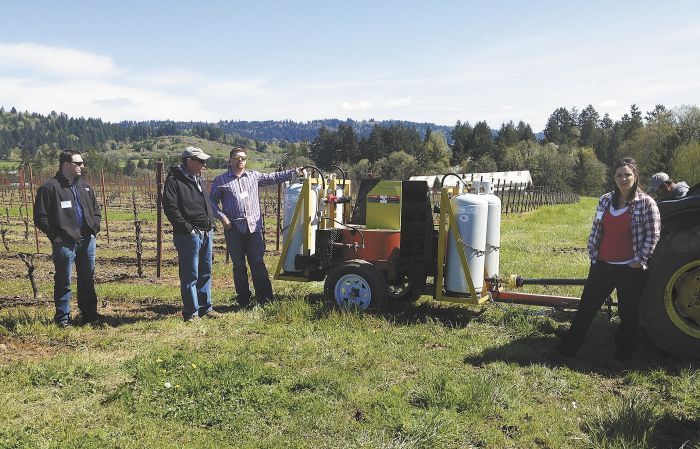Bunch of Hot Air?

By Jessica Cortell
On April 9, Adelsheim Vineyard and Agrothermal Systems co-hosted a lunch for vineyard managers, wine writers and others to demo equipment used for thermal plant treatment (TPT) in vineyards and to do a blind taste from wines made with and without the treatment. Interestingly enough, all but one person at the lunch preferred the wine from the fruit receiving heat treatment.
The concept is that by blowing hot air (300°F) into the canopy from propane powered jets, you can control pests and diseases without harming the grapevine. More testing is needed this coming season, but early results look promising. Additional intriguing benefits could include improvements in fruitset (number of berries per cluster), changes in phenolic compounds contributing to astringency, mouthfeel and color in wines, more rapid accumulation of sugars and differences in the aroma and flavor profiles.
Chad Vargas, the viticulturalist at Adelsheim, trialed the technology in 2012 and expanded its use in 2013. That year, the Newberg winery executed approximately 10 passes starting at bloom. This year they want to start closer to budbreak to determine the influence on early berry development and phenolics. The tractor can perform the treatment at 3.5 mph and can cover about two acres per hour, depending on the row spacing. The hot air travels at 35 mph through the canopy, takes about 6 gallons of propane per hour and costs about $250 each season for 10 to 12 passes. The idea is that fungicide sprays could be cut in half with this sustainable control method.
Next, we tasted the wines blind. While both wines were very good, there were differences in aromas, flavors, mouthfeel and color. My impressions were that the wine from the TPT vines was more complex, tended toward riper black fruit rather than red, darker color and had improved mouthfeel. These differences would make sense if the TPT advanced development of various aspects of ripening.
Additional benefits might be to use TPT to improve fruitset, particularly in Oregon where we have cool rainy weather during bloom; we have variable yields from year to year due to weather events as well as other factors. Growers in Oregon could benefit from more consistency. Another potential use could be to dry out fruit after rain events leading up to harvest, such as what we experienced in 2013.
Speakers at the lunch were Dave Paige, Adelsheim’s winemaker, as well as Marty Fischer, CEO of Agrothermal. Paige stated that his initial assessment with winemaking was simply to determine if the TPT was having any negative impacts on the wines. While the differences are subtle, he was pleased to find that not only were there no negative impacts but that he actually prefers the results. He felt the wine was brighter, more youthful with nice black cherry notes. They plan to expand the treatments to additional blocks but are being cautious in their approach.
Fischer said they have been finding improved wine quality with a trial done at Fresno State. They also found an increase in fruitset of 30 percent but only about a seven percent increase in yield. This could have to do with having more but smaller berries; however, further analysis needs to be done to confirm differences in berry size, seed number and other variables.
Fischer plans to conduct more thorough research this season on how the TPT influences fruitset and how it impacts powdery mildew spores. They plan to improve the equipment design to carry smaller propane tanks with articulating heat vents adjustable for different row widths. They hope to have at least one unit in Oregon this season for use and testing.
Keep an eye out for tractors blowing hot air!










